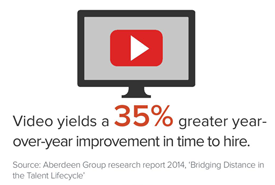A recent global survey, Global View: Business Video Conferencing Usage and Trends, conducted by Redshift Research on behalf of Polycom, Inc., dives into recent shifts in the way HR is communicating and shaping business culture.
Data for the report was collected from 1,205 business decision makers in four regions and 12 countries. Major discoveries of the report included the ways Human Resource executives perceive and are using video and video conferencing technology.
The data suggests that a move towards video provides advantages for talent management, staffing, training, productivity and flexible work enablement.
A tool now widely used worldwide in HR
Data from the survey tells us video is widely used by HR departments across the world. Polycom’s study found that video conferencing ranked as a Top 3 tool for communications, with HR respondents ranking email as the number one preferred communications tool (88 percent), followed by voice-conference calls at 62 percent and video conferencing at 46 percent.
Interestingly, HR executives who use video at work today said they would prefer video collaboration to email as their top method of business communication within three years.
HR executives that participated in the study saw clear benefits of using video communication tools over other forms of communication – with 98 percent of the Human Resources executives surveyed reporting that video conferencing helps companies work through issues of distance and cultural barriers to ultimately improve productivity amongst their teams.
Advantages of video conferencing
Respondents from the survey who use video conferencing today stated that the top advantages of this method of communication are:
- Better collaboration between globally dispersed colleagues (54 percent);
- Greater clarity of topics being discussed (45 percent); and,
- More efficient meetings (44 percent).
Some 76 percent of respondents report that they use video conferencing at work, and 83 percent of respondents (with nearly 90 percent of those in their 20’s and 30’s) use consumer video conference solutions at home today. Laptops and desktops were the most popular form of business video conferencing, followed by conference rooms, and then mobile devices.
A need to be mobile — and connected
Inside and outside of the workplace, we’re seeing a movement towards video as the newest trend in keeping us better connected. Whether this is the addition of video features to major social media platforms, or businesses using video conferencing more frequently, it’s clear that video is on the rise.
When you add in the increased focus on workplace flexibility by many organizations and a workforce that places increasingly more importance on the ability to be mobile and highly connected, integrating video communication tools in the workplace makes a lot of sense.
This originally appeared on China Gorman’s blog at ChinaGorman.com.
